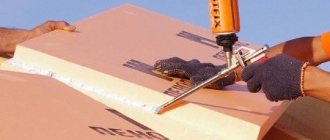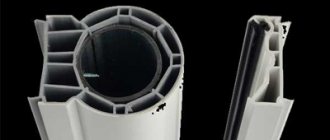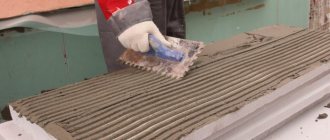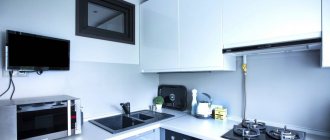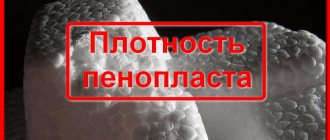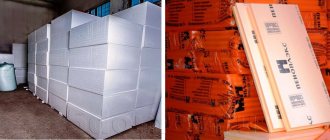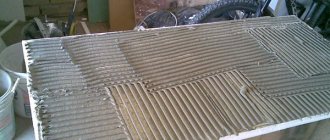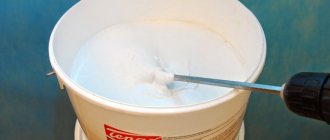Polystyrene foam (expanded polystyrene) is used in repair and construction. It is environmentally friendly and is used for thermal insulation. Properly selected adhesive for polystyrene foam will reliably bond it to any surface and extend the service life of the insulating structure.
Even a beginner can work with glue at home. Polystyrene foam can be glued to metal, wood, concrete, plastic, and connected to each other. Often attached to the ceiling in the form of ceiling skirting boards and tiles.
Requirements
Expanded polystyrene (polystyrene) is a material that can be destroyed by solvents and other aggressive substances. Therefore, the composition should not contain:
- ketone solvents;
- acetone;
- nitrogen compounds (nitromethane, nitrobenzene);
- chlorine derivatives;
- gasoline, white spirit, kerosene;
- alcohol and ether components.
The scope of application must also be taken into account: for external or internal work. Outdoors and for facades you will need frost-resistant adhesive.
The packaging of each composition contains instructions for use. It indicates which substrates can be glued.
What is it for?
The material is glued together mainly when decoratively finishing the ceiling, when gluing together foam structures, etc. If we take, for example, finishing the ceiling, then polystyrene foam is one of the best materials, since it is hard, lightweight, durable, and It is also moisture resistant.
Another example is the creation of sculptures from foam plastic for their subsequent placement in the garden or in the house.
One surface of the foam is glued to another, already fixed earlier, to increase the insulating qualities, or directly glued together to thicken it. Based on practice, in such cases ordinary glue is easily used.
If the volume of work is small, then PVA glue will be sufficient, but in the case of larger construction work, adhesive and binding liquids are used.
Types and brands of adhesives
For gluing are used:
- dry (powder, plaster-adhesive) and ready-made liquid mixtures;
- liquid Nails;
- adhesive foam (polyurethane);
- sealants.
Dry (powder)
These are plaster and adhesive mixtures. Packaged in large bags up to 30 kg per package. To prepare, the powder is diluted with water in the proportions specified in the instructions. The composition is based on the inclusion of cement, gypsum and polymer components. Externally, the powder is similar to putty or plaster, but the gluing result is more durable.
Suitable for indoor and outdoor use. Adhere well to concrete, wood and other substrates. Used as a seal for cracks, joints and seams. Consumption per 1 m2 ranges from one and a half to two kilograms.
For a reliable result, the walls are processed before gluing: they are cleaned of dirt, dust, dried and primed.
When diluting the powder with water, the liquid is added gradually in small quantities, and the water itself is constantly stirred. This will prevent lumps from forming. Application is possible in a continuous layer over the entire surface or in separate lines with a small distance between each.
Powder adhesives:
- Ceresit ST-83;
- Knauf Perlfix;
- Avangard-K;
- Primus;
- Volma";
- Armierungs-Gewebekleber.
Avangard-K allows gluing not only to concrete, but also to brick walls. Packaging 25 kg in one package. There is a frost-resistant option for the street.
Another Bergauf ISOFIX cement-sand mixture, which contains fillers and special additives, plasticizers. Apply a layer up to 3 mm thick. After mixing the solution, it can be used for one and a half hours, and the position of the EPS can be adjusted for a quarter of an hour. Can be used indoors and outdoors.
Polyurethane adhesive foam
Polyurethane adhesive in the form of foam (foam glue) connects all types of plastic, including polystyrene foam, with any substrate (OSB, metal, concrete, plaster, wood, aerated concrete and foam blocks). You can glue the foam together.
There are specialized formulations on the market. They are marked with an inscription on the packaging (for polystyrene foam).
The gluing plane is not important. Both horizontal and vertical surfaces are glued. The connection holds firmly both indoors and outdoors.
Installation is possible only with a construction gun, on which a cylinder is placed on top of the legs. The application technology is shown in the figure.
It is convenient to use foam adhesive. The work is done quickly. Has low consumption per sq. m. The cylinder is enough for 10-15 m2. Foam adhesives are resistant to moisture, do not freeze, and have high adhesion.
There is no need to prepare, the cylinder is ready to use. The maximum result of the coupling is evident after half an hour, while pressing the parts is enough for only 20 seconds.
Popular brands:
- Tytan Styro 753;
- Penosil;
- Ceresit CT-84 Express.
PVA
PVA is cheap, so it is often chosen for gluing extruded polystyrene foam (EPS). The reliability of the adhesion is not the highest, so it is more suitable for gluing crafts. It is better to give preference to specialized mixtures.
PVA fills voids in walls well. Additionally, foam plates are attached to dowels. Usually PVA is applied in two layers.
Suitable polyvinyl acetate adhesives include Moment Stolyar and PVA-MB.
- Moment Joiner. Universal composition for repair. Supplied in packages of different volumes, from 100 g to 30 kg. The drying time is fast and the seam is reliable. It does not destroy the structure of polystyrene.
- PVA-MB. The composition contains special plasticizers that improve the quality of adhesion. The hardening time of the seam is longer than that of conventional PVA.
Polyurethane foam
An effective composition, but it has another purpose - sealing seams, cracks, strengthening concrete structures.
If you glue with polyurethane foam, the following consequences may occur:
- the foam after complete drying increases in volume, which can damage the foam and deform the entire structure;
- Foam can increase in volume in different ways, so voids form in some places and the thermal insulation properties decrease.
Polyurethane foam has a high consumption per square meter. m of surface, which increases the cost of gluing.
Recommendations for use:
- make sure that the foam is suitable for gluing foam and does not destroy it;
- install the polystyrene itself with a different composition;
- seal the joints with polyurethane foam;
- the foam dries quickly, so you need to work in the same way;
- Reducing consumption is possible with a glue gun.
Liquid Nails
They have a high price, but the gluing result is very high quality. The best choice would be specialized polyurethane adhesives.
Liquid nails have an optimal balance of qualities (ease of use, service life, adhesion). Polystyrene foam attaches perfectly to polystyrene foam, metal, plastic, concrete, wood, and other materials.
Professionals recommend gluing metal using a combination of liquid nails and polyurethane mixtures.
Increasing adhesion to the surface is achieved by preparing it: cleaning, degreasing, priming.
the high price causes the use of nails only on small bases.
The most popular composition is “Moment Montage”.
Option 3. Silicone sealant.
Despite the fact that the sealant is designed to seal holes between seams, its scope is extremely wide.
An excellent option for gluing PVC panels is a non-expanding sealant based on polyurethane foam - its adhesion to plastic is quite high. Before use, carefully read the composition and what it is suitable for.
One of the distinguishing features of sealant before adhesive is its ability to withstand large temperature changes while maintaining elasticity.
Tip: To make the job easier, choose a sealant with a gun-shaped applicator.
We recommend choosing products from well-known manufacturers:
- "Moment";
- "Tytan"
- "Denbraven"
- "Ceresit";
- "Soudal";
- "Silka"
Advice: if, due to inexperience, you carelessly applied the sealant and it came out from the outside of the plastic panel, do not wipe it off immediately. Wait until it dries, and then carefully remove it with a spatula or knife.
The drying time of the adhesive-sealant depends on its composition and is indicated on the packaging. Typically, the initial setting of the composition occurs after 20 minutes, and final adhesion - from 4 to 24 hours.
Lifehack! Convenient use of silicone sealant. Without a gun.
Description of brands
Among the highest quality brands:
- Ceresit Ct 83 Strong Fix;
- Ceresit Express Ct 84;
- Tytan Styro 753 Gun;
- Knauf Klebespachtel;
- Prospectors Teploizol;
- TechnoNIKOL Professional;
- Penoplex Fastfix;
- Bitumast.
Ceresit CT 83
Ceresit ST 83 brand adhesive is very durable, can withstand heavy loads, and has high adhesion. The mixture is vapor-permeable, so moisture does not linger in the room where the heat-insulating boards were attached with the plaster-adhesive mixture. Does not ignite when exposed to fire. The composition is used to attach heavy slabs of large thickness (up to 20 cm) to the wall outside the house.
You can work with the ST 83 brand at zero temperatures, but then the powder is diluted in heated water to +30 °C.
Advantages:
- environmental friendliness;
- low consumption;
- vapor permeability;
- speed of preparation.
Flaws:
- price;
- inadmissibility of gluing on other paints and varnishes;
- sticker on concrete only three months after it is poured;
- You can mix a good solution without lumps only with a mixer or a drill with a mixing attachment at 400-800 rpm.
Ceresit CT 84
This is polyurethane foam, the basis of the composition is polyurethane and flammable gas. ST 84 – frost-resistant glue. Used at sub-zero temperatures down to -10 °C. In cold weather, the composition hardens several times longer, up to 7-10 hours. While in warm weather, hardening takes only 2 hours.
ST 84 is applied first along the perimeter of the heat-insulating sheet, then diagonally. Presses against the surface. Exposed mixture residues can only be removed with a solvent.
Advantages:
- absence of freons;
- moisture and water resistance;
- consumption;
- simplicity and speed of installation.
Flaws:
- poor adhesion to paint and varnish coatings;
- mandatory fastening with dowels;
- Before applying to foam blocks, the latter require priming.
Tytan Styro 753 Gun
Titan Styro foam in 750 g cans. Application requires a construction gun, which speeds up installation.
The foam layer is no more than 5 mm, this is a drawback, because outside the house such fastening is unreliable. Additionally, fastening with dowels is required.
Bonds EPS sheets to brick, concrete, mastic, plaster and cement bases.
Advantages:
- economical consumption;
- the foam is ready to use, does not require preparation;
- simplicity and speed of application (with a construction gun);
- good adhesion to metal, concrete, brick, plastic and wooden surfaces.
Flaws:
- price;
- requires additional fastening with dowels;
- operation only at t °C above zero.
Knauf Klebespachtel
Powder that is diluted with water. Packaging: 25 kg. For interior and exterior work.
Application is possible by machine using G4 and Monojet pumps. This significantly speeds up coverage of large areas.
Suitable for EPPS.
Advantages:
- Can be used for reinforcement;
- setting time – 1 hour;
- the presence of a machine application method;
- operating temperature range.
Flaws:
- consumption;
- packaging is heavy, inconvenient for transportation;
- takes a long time to apply by hand.
Prospectors Teploizol
Manufacturer – Russia. Release form: powder. Fixing foam plastic to the wall outside the house. In original packaging the shelf life is up to one year.
Advantages:
- no need to pre-treat the surface;
- low consumption;
- used for reinforcement;
- After mixing, the solution is suitable for three hours.
Flaws:
- high price;
- discomfort during transportation;
- slow period of complete hardening (three days);
- operating temperature only above +10 °C.
TechnoNIKOL Professional
TechnoNIKOL Professional adhesive foam has a polyurethane-based composition. Used as a sealant. Fastens all types of polystyrene foam.
Operating temperature up to 30 degrees Celsius, but not below zero.
Advantages:
- price;
- resistance to water, moisture, fungi and mold;
- the ability to correct the position of the slabs within 20 minutes after fixing;
- high adhesion;
- Suitable for external and internal installations.
Flaws:
- installation only at positive temperatures °C;
- installation only with a construction gun;
- chem. reaction when interacting with silicone and polyethylene;
- the required humidity level is 50% for rapid hardening.
Penoplex Fastfix
Penoplex is produced in 750 g cylinders, inside of which there is foam material. Used in conjunction with a mounting gun for fastening extruded and foamed polystyrene foam. Fixation is possible on concrete, brick, ceramic surfaces, and aerated concrete blocks.
It is used both outside and indoors for insulating loggias, rooms, and roofs.
Has a light blue tint. Dries in 10 hours and withstands 100 frost cycles. Installation temperature from -10 °C to +40 °C.
Apply with a construction gun in vertical continuous strips with a distance of 5 cm between each. Press the insulation sheet after 5-7 minutes and strengthen it with dowels.
Bitumast
Resinous bitumen for extruded polystyrene foam. Half a kg of mixture is consumed per 1 m2. Bitumast dries for two days. Withstands 100 freezing cycles. The gluing temperature is only above zero, up to +30 °C.
Cannot be applied to facades or inside rooms or buildings.
Bitumen adhesive needs to be pre-diluted with water. Has good adhesion to any type of substrate. The setting time is long compared to other mixtures. The sheets will have to be pressed until the polystyrene holds on itself and does not slide off. Very high price.
Main Applications
Expanded polystyrene is used in many areas. Many products and coatings are made from this material. Due to the fact that it perfectly retains thermal energy, it is often used for thermal insulation. The most common areas of application of expanded polystyrene include:
- Construction. In this area, the material in question is used for insulating buildings, residential buildings, hangars and garages.
- Shipbuilding. Lightweight boats, dinghies and belts are made from foamed polystyrene. They also fill the compartments of small ships.
- Medicine. The material is used to make containers for transporting medications and internal organs.
- Furniture manufacturing.
- Production of packaging, wrappers, bags, etc.
- Outdoor advertising: signs, banners.
- Manufacturing of clothing items.
Consumption per 1m2
Calculation of consumption per sq. m. is needed to determine the required amount of material to purchase. It is impossible to calculate the exact amount. This is influenced by factors:
- material, its density and ability to absorb;
- consumption of a specific type and brand of mixture.
The average data is shown in the table.
| Type of composition | Consumption |
| Dry | 500 gr. / m² |
| Bituminous | 800-1000 gr. / m² |
| Polyurethane | 1 cylinder per 8-10 m² |
Sequence of actions during operation
To paint the outside and inside, select the desired type of composition. After choosing, you can start painting the product yourself. The easiest way to do this is to use a product in an aerosol package.
To paint polystyrene foam with your own hands, it is best to choose spray paint
Before starting work, shake the can for 1-2 minutes and then evenly cover the surface from a distance of 30 cm in 2-3 layers. Each time it must dry and only then can the next layer be applied. This method is considered the simplest if you learn how to work with a cylinder.
If the composition in a jar is used, painting is done using a brush or roller. The required amount of water is added to the paint to achieve a suitable consistency. If several tones are used, the composition should be mixed well before coating to obtain an even color. If the elements are painted in different colors, then the brush must be rinsed well with water each time.
To consolidate the result, you can use varnish. A special water-based varnish is often used in combination with acrylic paint to further protect the surface of the foam.
How to glue foam
The gluing technology depends on the installation conditions of the foam and the material to which it is attached.
To the foam
Polystyrene foam is attached to other foam plastic using the adhesives described above.
There is a specialized brand called Styroglue. It will best glue together two parts of foam plastic and other substrates. It is not as widespread on the market as other brands, but the price is not the highest.
Advantages:
- Styroglue is transparent in structure and will be invisible on light or white polystyrene;
- it dries quickly (from 20 seconds to 1 minute);
- resistant to moisture, frost, fungal formations, used indoors and outdoors.
Flaws:
- It is necessary to work with protective gloves, the glue sets quickly and is difficult to remove from your hands;
- cold affects the properties of the glue, it becomes thicker. In cold weather, keep the container in heated water.
When using PVA, it is applied to both parts/surfaces. Allow time to dry slightly, then apply another layer and squeeze the parts for a few minutes.
The parts are also fixed:
- epoxy resin with hardener;
- glue sticks and a heat gun.
The heat gun is suitable for fastening several parts of polystyrene foam into one structure. Extremely hot hot melt adhesive can burn through the material. It hardens quickly, you have to work the same way.
The method does not require professional skills. A beginner can work at home.
When attaching regular foam to extruded foam, the latter is treated with a needle roller for better adhesion.
To concrete
It can be attached to concrete without lathing. Tools and consumables you will need:
- primer mixture;
- spatula (for application);
- electric drill with a mixing attachment (for mixing the solution);
- glue.
A powder mixture is selected for gluing . It is diluted with ordinary water. The proportions are indicated in the instructions. The water in the container is mixed with a drill with a mixing attachment and powder is gradually added. If you don't have a drill, replace it with a construction mixer. The mixture must be allowed to brew so that it acquires adhesive qualities.
The effectiveness of adhesion is achieved by preparing the concrete base. The surface is thoroughly cleaned, all dirt, dust, stains are removed, and a primer is applied.
Next, apply the mass onto the foam block:
- if the walls have slight unevenness and defects, the glue is applied in continuous lines, with indentations of 2 cm made from the edges of the sheet;
- when the walls are curved more than 2 cm, apply with dotted lines (to get rid of excess air);
- the middle of the slab is also lubricated with the solution.
The sheet is then pressed tightly against the concrete wall or floor. Excess glue that appears along the edges is removed with a rag.
Builders advise fastening polystyrene slabs with dowels in each corner and in the center.
In addition to the dry mixture, you can use adhesive-sealant, liquid nails and dowels, and a polyurethane-based composition.
To metal
It will be possible to properly glue the foam to the metal if you lay burlap between them.
The metal must be clean and free of traces of corrosion (rust).
For gluing the following are used:
- adhesive sprays (aerosol, in cans);
- silicone sealants;
- polyurethane foam or polyurethane based;
- powder dry compositions;
- small areas can be glued with double-sided tape.
The best option would be polyurethane aerosol adhesive, available in cans, or foam adhesive. The foam adhesive composition is especially good when installing foam plastic on surfaces that are located at an angle or have uneven surfaces. Foam is applied pointwise (minimum 5 points). Solid strips are smeared with powder solutions.
To the tree
Polystyrene foam can be attached to plywood, boards, lining, OSB boards. Polystyrene sheets are glued to wooden bases in the same way.
The only thing is that nuances are observed due to the characteristics of the tree.
- The wood is cleaned, dirt, dust, grease stains are removed, and completely dried.
- The wood is primed in two or three layers. It is advisable to apply an antifungal primer.
- When fastening under windows, a reinforcing mesh is applied to a wooden base using a stapler.
- The cracks and empty spaces are sealed with polyurethane foam. After the foam has hardened, excess parts are removed.
- Any protrusions and irregularities are corrected.
- If the wood is varnished, it must be removed, since the composition of the varnish coating can corrode the foam.
- It is better to attach polystyrene foam to wood using anti-fungal and anti-mold additives.
The adhesive mixture is applied in strips along the sheet. Indentations of 2 cm are made from the edges. Then diagonal stripes are drawn. The sheet is pressed against the wood, and any residual glue that appears is removed with a rag.
Easy way to cut
The presented approaches make it easy to cut foam. Folk craftsmen give advice on how to cut such material. They came up with another way. It will be quite effective, especially when cutting large sheets of foam.
To do this you will need a thin and strong string. Its ends are tied to wooden handles. If the sheet is large, you need to do the work together with an assistant. In this case, there are 2 people on both sides of the array. Everyone takes a wooden handle with a string attached. Next, they move the thread along the pre-drawn markings. It heats up from friction.
The material is easily and quickly cut. If the leaf is small, you can perform this procedure yourself.
Recommendations
When working with foam, do not use types of glue that are intended for other surfaces, such as metal, wood or fabric. It is likely that they will fulfill their function, but at an unreasonably high cost. In addition, they can ruin the foam. Those types of glue that contain a solvent for plastics: acetone or alcohol are not suitable for this material. For the same reason, do not use all-purpose rubber cement.
Remember that foam is plastic filled with air. It is very light and fragile. Work with it carefully, do not press hard when gluing, as the craft may be damaged. When working with glue at home, use personal protective equipment such as masks and gloves, and ventilate the area well.
Homemade cutter
You can create a thermal cutter yourself. To do this, you need to collect a set of necessary parts. First of all, you will need a small transformer. You can take this part, for example, from an old TV.
In this case, you will also need to cut the foam with a nichrome string. It is pulled between two long screws. They must be secured to a wooden plank. Such material is known to not conduct current. Therefore, electricity from the transformer will only flow to the screws and string.
After connecting all elements, the voltage should be adjusted. It depends on the thickness of the nichrome thread. A string that is too hot will not allow you to cut the material properly.
Features of applying adhesive mass
To work, you need to know the features of polystyrene foam and how to glue it to other surfaces. You also need to adhere to a clear sequence. So, application consists of the following steps:
- Surface preparation and cleaning . Working with foam is very easy if you choose the right glue. All that is necessary for this is to apply the composition to the foam element and press it to the required plane. Then you need to wait until the glue dries. But before gluing, you need to remove particles of dirt and dust from the surface using a dry cloth. Gluing to a contaminated base will negatively affect the adhesive ability, which will significantly weaken the fixation.
- Applying the adhesive mixture. For maximum effective fixation, an even and thin layer should be applied to the surface. If there is no need for strong fixation, then the glue can be applied in strips or drops. If you have a very large foam part, you can pour glue directly into the groove or treat the surface with a brush.
- Installation of material . It must be pressed carefully but firmly so that the composition can come into contact with the surface being treated. This will give you about one to two minutes to adjust the position of the foam.
- Drying. After that, you just have to wait for the glue to dry. Depending on the dimensions of the surface, the type of adhesive solution and its volume, complete drying time varies from five to ten minutes to three to five hours. During this period, you should not touch the surface, otherwise the procedure will have to be repeated.
Expanded polystyrene is very easy to glue, and almost any adhesive is suitable for this job. In addition, it is extremely lightweight and does not cause any problems during installation and operation.
Features of applying adhesive mass
To work, you need to know the features of polystyrene foam and how to glue it to other surfaces. You also need to adhere to a clear sequence. So, application consists of the following steps:
- Surface preparation and cleaning . Working with foam is very easy if you choose the right glue. All that is necessary for this is to apply the composition to the foam element and press it to the required plane. Then you need to wait until the glue dries. But before gluing, you need to remove particles of dirt and dust from the surface using a dry cloth. Gluing to a contaminated base will negatively affect the adhesive ability, which will significantly weaken the fixation.
- Applying the adhesive mixture. For maximum effective fixation, an even and thin layer should be applied to the surface. If there is no need for strong fixation, then the glue can be applied in strips or drops. If you have a very large foam part, you can pour glue directly into the groove or treat the surface with a brush.
- Installation of material . It must be pressed carefully but firmly so that the composition can come into contact with the surface being treated. This will give you about one to two minutes to adjust the position of the foam.
- Drying. After that, you just have to wait for the glue to dry. Depending on the dimensions of the surface, the type of adhesive solution and its volume, complete drying time varies from five to ten minutes to three to five hours. During this period, you should not touch the surface, otherwise the procedure will have to be repeated.
Expanded polystyrene is very easy to glue, and almost any adhesive is suitable for this job. In addition, it is extremely lightweight and does not cause any problems during installation and operation.
Results
In our article, we talked about the advantages and disadvantages of extruded polystyrene foam, how this building material is produced, and why it is considered the most popular of insulation materials.
Together with you, we found out what extruded polystyrene foam can be glued to, what adhesive compositions to use and how to use them. We introduced you to the types of adhesive mixtures for penoplex and characterized each of them.
You learned how to install slabs to the ceiling using the example of “Fast fix” glue. Which adhesive to choose is up to you. The main thing is to take into account the rules for choosing glue for extruded polystyrene foam, the requirements for adhesive compositions, and follow the instructions for installing polystyrene foam boards.
